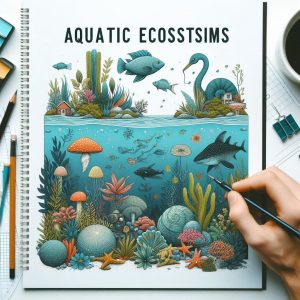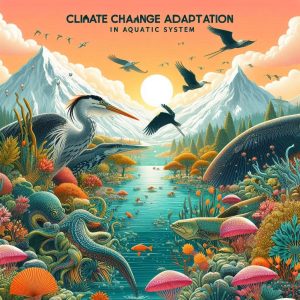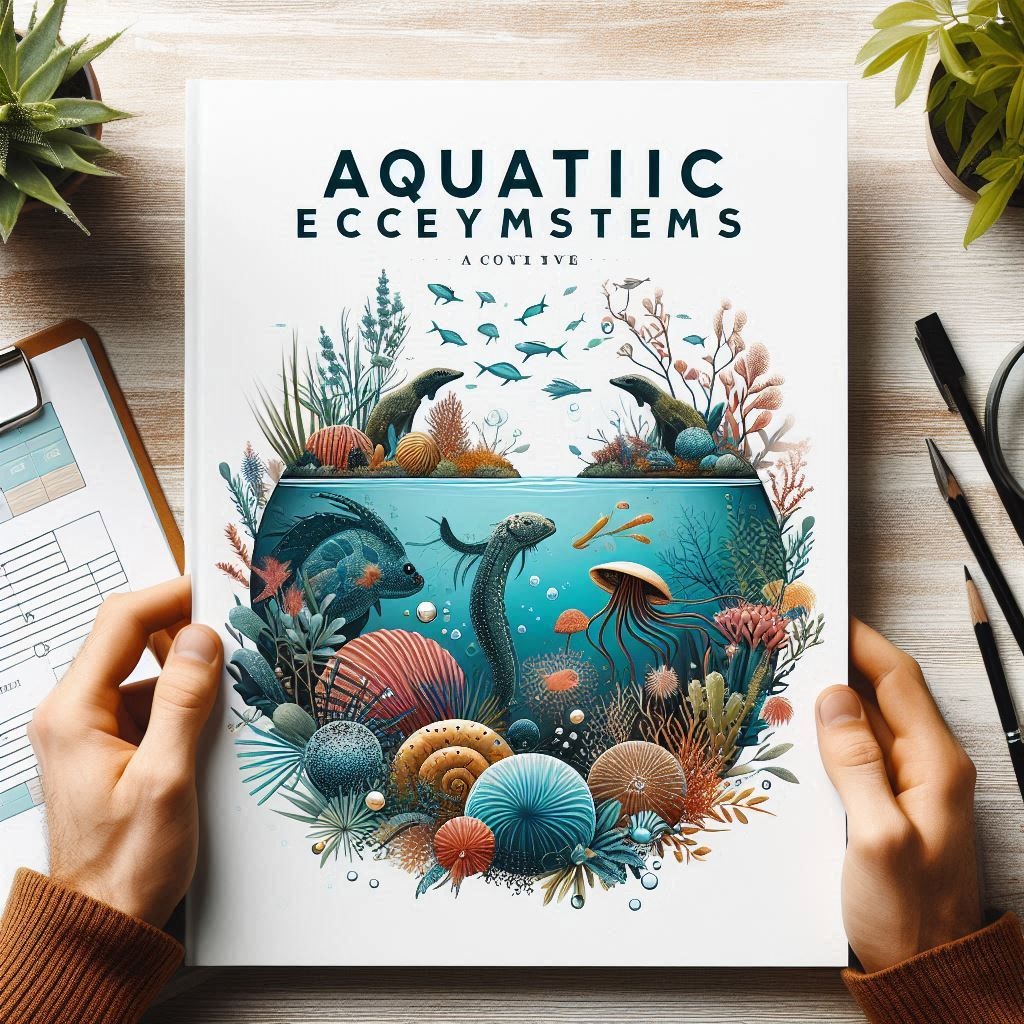Aquatic Ecosystems: A Comprehensive Overview
Aquatic ecosystems, encompassing both freshwater and marine environments, are vital components of the Earth’s biosphere. These ecosystems play crucial roles in supporting biodiversity, regulating climate, and providing resources essential for human survival. This article delves into the various types of aquatic ecosystems, their ecological significance, current threats, and conservation efforts.
Types of Aquatic Ecosystems
1. Freshwater Ecosystems
Freshwater ecosystems are characterized by low salinity and include rivers, lakes, wetlands, and ponds. They are crucial for drinking water, agriculture, and supporting diverse species. Key components of freshwater ecosystems include:
Rivers and Streams: Flowing water systems that transport nutrients and support a wide range of aquatic life. For more on river ecosystems, visit Rivers.gov.
Lakes and Ponds: Standing water bodies that provide habitat for numerous species and serve as important freshwater resources. Learn more from Lake Scientists.
Wetlands: Areas where water saturates the soil, supporting unique plant and animal life. Visit Wetlands International for detailed information.
2. Marine Ecosystems
Marine ecosystems are found in the world’s oceans and seas, characterized by high salinity. These ecosystems are crucial for global climate regulation, nutrient cycling, and providing habitat for marine life. Key marine ecosystems include:
Coral Reefs: Biodiverse underwater ecosystems built by coral polyps, providing habitat and food for numerous marine species. Learn more from Coral Cay Conservation.
Mangroves: Coastal forests that protect shorelines and support diverse marine and terrestrial species. Explore Mangrove Alliance for more information.
Kelp Forests: Underwater forests of kelp that provide habitat for marine life and support coastal ecosystems. For details, visit ReefWatch.
Ecological Significance of Aquatic Ecosystems
1. Biodiversity Hotspots
Aquatic ecosystems are home to a vast array of species, many of which are found nowhere else. These ecosystems support complex food webs and contribute to global biodiversity. For example, coral reefs are often referred to as the “rainforests of the sea” due to their high levels of species diversity. Explore more on aquatic biodiversity at Biodiversity Library.
2. Climate Regulation
Aquatic ecosystems play a crucial role in regulating the Earth’s climate. Oceans absorb and store large amounts of carbon dioxide, while wetlands act as carbon sinks. Additionally, aquatic plants such as phytoplankton contribute to global oxygen production. Learn about climate regulation by aquatic systems from Climate.gov.
3. Water Quality and Ecosystem Services
Aquatic ecosystems provide essential services such as water purification, flood control, and nutrient cycling. Wetlands filter pollutants from water, while riparian zones along rivers help reduce erosion and manage runoff. For more on ecosystem services, visit Millennium Ecosystem Assessment.

Threats to Aquatic Ecosystems
1. Pollution
Pollution from agricultural runoff, industrial discharges, and plastic waste poses significant threats to aquatic ecosystems. Nutrient pollution can lead to algal blooms, hypoxia, and dead zones, while plastic waste impacts marine life through ingestion and entanglement. Explore the effects of pollution on aquatic ecosystems at WHO Fact Sheet on Water Pollution.
2. Habitat Destruction
The destruction of aquatic habitats due to development, deforestation, and dredging leads to loss of biodiversity and disruption of ecosystem functions. For instance, coastal development threatens mangroves and coral reefs, while river modifications affect freshwater habitats. For more information, visit IUCN on Habitat Loss.
3. Climate Change
Climate change poses significant threats to aquatic ecosystems, impacting both freshwater and marine environments in various ways. The increasing concentration of greenhouse gases, rising temperatures, and altered precipitation patterns are contributing to profound changes in aquatic habitats and the organisms that depend on them.
1. Temperature Rise
One of the most direct effects of climate change on aquatic ecosystems is the increase in water temperature. Warmer temperatures can lead to:
Coral Bleaching: Elevated sea temperatures cause coral polyps to expel the symbiotic algae living within them, leading to bleaching and potentially widespread coral death. For more information, visit NOAA’s Coral Reefs.
Changes in Species Distribution: As water temperatures rise, many aquatic species migrate towards cooler waters, altering ecosystem dynamics and potentially leading to the disruption of food webs. Learn more at Nature’s Species Distribution.
Thermal Stress: Increased temperatures can cause thermal stress to aquatic organisms, affecting their health, reproduction, and survival rates. For details, visit Woods Hole Oceanographic Institution.
2. Ocean Acidification
Ocean acidification, caused by the absorption of excess atmospheric CO2 by seawater, is another critical issue impacting aquatic ecosystems. The effects include:
Impact on Shellfish: Acidic waters interfere with the ability of shellfish to form calcium carbonate shells, impacting their growth and survival. For more details, visit Earth Lab on Ocean Acidification.
Disruption of Marine Food Chains: Acidification can affect the sensory and feeding behaviors of marine species, leading to disruptions in marine food chains. Learn more at Science Daily on Marine Food Chains.
Coral Reef Health: Ocean acidification affects coral reef health by compromising the ability of corals to build their skeletons, which can lead to weakened reef structures. Visit Coral Triangle Initiative for more information.
3. Altered Hydrological Cycles
Climate change affects precipitation patterns, leading to changes in the hydrological cycles of freshwater ecosystems. Impacts include
Changes in Streamflow: Variations in precipitation and snowmelt alter streamflow patterns, affecting water availability and ecosystem function. For more on streamflow changes, visit NOAA on Precipitation.
Impact on Water Resources: Changes in precipitation can lead to water scarcity or flooding, impacting freshwater ecosystems and human communities. Explore more at World Resources Institute on Water Management.
Shifts in Ecosystem Dynamics: Changes in hydrological patterns can alter species distributions, affect aquatic productivity, and disrupt ecological interactions. For detailed insights, visit IPCC Special Reports.
4. Sea Level Rise
The melting of polar ice caps and glaciers, combined with the thermal expansion of seawater, contributes to rising sea levels. This phenomenon has several effects on aquatic ecosystems:
Coastal Erosion: Rising sea levels lead to increased coastal erosion, threatening habitats such as mangroves and salt marshes. For further information, visit ESA’s Coastal Erosion Monitoring.
Habitat Loss: Loss of critical coastal habitats due to sea level rise impacts biodiversity and the provision of ecosystem services. Learn more from Nature Conservancy on Sea Level Rise.
Inundation of Low-Lying Areas: Low-lying areas and islands face increased risk of inundation, which can displace communities and impact freshwater and marine ecosystems.
For details on climate impacts, check out the IPCC Special Report on Climate Change.
Conservation and Management Efforts
1. Marine Protected Areas (MPAs)
Marine Protected Areas (MPAs) are designated regions in oceans, seas, and coastal areas where human activities are managed to protect marine ecosystems and biodiversity. These areas help conserve critical habitats, such as coral reefs and mangroves, by regulating fishing, tourism, and other activities. MPAs contribute to the recovery of overexploited species, enhance resilience against climate change, and support marine research. For more information on MPAs, visit National Geographic’s Marine Protected Areas.
2. Riparian Buffer Zones
Riparian buffer zones are vegetated areas along riverbanks that act as natural filters, reducing runoff and erosion while enhancing water quality. These zones support biodiversity by providing habitat for wildlife and stabilizing riverbanks. Effective management of riparian buffers involves planting native vegetation, controlling invasive species, and preventing development. Learn more about riparian buffers from EPA’s Riparian Buffer Zones.
3. Sustainable Fisheries Management
Sustainable fisheries management aims to balance the needs of human populations with the health of fish populations and aquatic ecosystems. Strategies include setting catch limits, protecting spawning grounds, and regulating fishing practices. By adopting sustainable practices, fisheries can maintain healthy fish stocks and reduce the impact on marine ecosystems. For more information on sustainable fisheries, visit FAO’s Sustainable Development Goal 14.
4. Restoration Projects
Restoration projects aim to rehabilitate degraded aquatic ecosystems, such as wetlands, coral reefs, and mangroves. These projects often involve removing pollutants, replanting native species, and restoring natural hydrological patterns. Successful restoration enhances ecosystem function, improves water quality, and supports biodiversity. Explore examples of restoration projects at Coastal Ecosystem Restoration Fund.
5. Public Awareness and Education
Raising public awareness and educating communities about the importance of aquatic ecosystems and conservation measures is essential for fostering environmental stewardship. Educational programs, community outreach, and citizen science initiatives help engage people in conservation efforts and promote sustainable practices. For resources on environmental education, visit Environmental Education.

Future Directions and Challenges
1. Climate Change Adaptation
Adaptation strategies are necessary to address the impacts of climate change on aquatic ecosystems. This includes enhancing the resilience of ecosystems through habitat restoration, implementing adaptive management practices, and reducing greenhouse gas emissions. For information on climate adaptation strategies, visit IPCC’s Sixth Assessment Report.
2. Integrating Technology and Innovation
The integration of technology and innovation, such as remote sensing, GIS, and environmental DNA (eDNA), is transforming the monitoring and management of aquatic ecosystems. These tools enable more accurate assessments of ecosystem health, track species distribution, and enhance conservation efforts. For examples of technological advancements, visit Nature’s Environmental Monitoring.
3. Policy and Governance
Effective policy and governance are crucial for the conservation and sustainable management of aquatic ecosystems. This includes implementing regulations, fostering international cooperation, and ensuring enforcement of environmental laws. Engaging stakeholders and integrating scientific research into policy decisions can enhance conservation outcomes. Learn more about environmental governance from United Nations Sustainable Development.
Conclusion:
Aquatic ecosystems are vital to the health of our planet, providing essential services and supporting a vast array of life forms. Addressing the challenges they face through effective conservation and management practices is crucial for ensuring their sustainability and resilience. By embracing innovative solutions, engaging communities, and fostering global cooperation, we can work towards preserving these invaluable ecosystems for future generations. For further reading and resources on aquatic ecosystems, explore Aquatic Ecosystems.org and WaterWorld.
FAQs about Aquatic Ecosystems
1. What are aquatic ecosystems?
Aquatic ecosystems are environments where water is the primary medium supporting life. They include various types such as marine (oceans and seas), freshwater (lakes, rivers, and wetlands), and estuarine (where freshwater meets saltwater). These ecosystems support a diverse array of organisms, from microscopic phytoplankton to large marine mammals. For a detailed overview, visit National Geographic’s Aquatic Ecosystem.
2. Why are aquatic ecosystems important?
Aquatic ecosystems are crucial for several reasons. They provide essential services such as oxygen production, climate regulation, nutrient cycling, and habitat for a wide range of species. They also support human activities like fishing, recreation, and transportation. Additionally, they play a role in regulating the Earth’s climate by absorbing carbon dioxide. For more information, see EPA’s Aquatic Ecosystems.
3. What are the major threats to aquatic ecosystems?
Major threats to aquatic ecosystems include pollution (from chemicals, plastics, and nutrients), habitat destruction (due to urbanization and deforestation), climate change (causing temperature shifts and ocean acidification), overfishing, and invasive species. These threats can lead to degradation of water quality, loss of biodiversity, and disruption of ecosystem functions. For details, visit World Resources Institute on Aquatic Threats.
4. How can we protect and conserve aquatic ecosystems?
Protecting and conserving aquatic ecosystems involves several strategies, including establishing protected areas, reducing pollution, promoting sustainable fishing practices, restoring degraded habitats, and raising public awareness about the importance of these ecosystems. Effective management requires collaboration between governments, organizations, and local communities. Learn more about conservation efforts at Nature Conservancy’s Conservation Efforts.
5. What role does climate change play in aquatic ecosystems?
Climate change affects aquatic ecosystems in multiple ways, including rising water temperatures, ocean acidification, altered precipitation patterns, and sea level rise. These changes can impact species distributions, disrupt food webs, and exacerbate existing threats. Adaptation and mitigation strategies are essential to address these impacts and protect aquatic environments. For more insights, visit IPCC Special Reports on Climate Change.
Disclaimers
The information provided in this article is intended for educational and informational purposes only. While every effort has been made to ensure the accuracy and reliability of the content, the rapidly evolving nature of scientific research means that new findings and insights may not be reflected here. Readers are encouraged to consult additional sources and experts for the most current information and guidance regarding aquatic ecosystems.
This article does not substitute for professional advice or recommendations. For specific concerns or queries related to aquatic ecosystems, conservation practices, or climate change impacts, please seek advice from qualified professionals or relevant organizations.The links provided are for informational purposes and are not endorsements of the content or views expressed by the external websites. We recommend reviewing the terms and conditions of any external sites before engaging with their content.
Cautions
When engaging with aquatic ecosystems, it is crucial to exercise caution and adhere to best practices to minimize environmental impact. Some key cautions include:
Avoiding Pollution: Ensure that no pollutants, chemicals, or waste are discharged into aquatic environments. Proper disposal and recycling of waste help protect water quality and ecosystem health.
Respecting Wildlife: Avoid disturbing wildlife and their habitats. Respect regulations regarding wildlife observation and refrain from feeding or touching animals, as this can cause stress and alter natural behaviors.
Practicing Sustainable Use: Engage in sustainable practices when using aquatic resources. This includes responsible fishing, boating, and recreational activities to minimize harm to ecosystems.
Monitoring Environmental Impact: Regularly monitor and assess the impact of activities on aquatic ecosystems. Engage in conservation efforts and support initiatives aimed at mitigating adverse effects.
Staying Informed: Keep up to date with the latest research and developments related to aquatic ecosystems and climate change. This helps in making informed decisions and contributing to effective conservation efforts.
By adhering to these cautions and actively participating in conservation efforts, individuals and communities can contribute to the protection and sustainability of aquatic ecosystems. For more detailed information and resources, explore Aquatic Ecosystems.org and WaterWorld.



